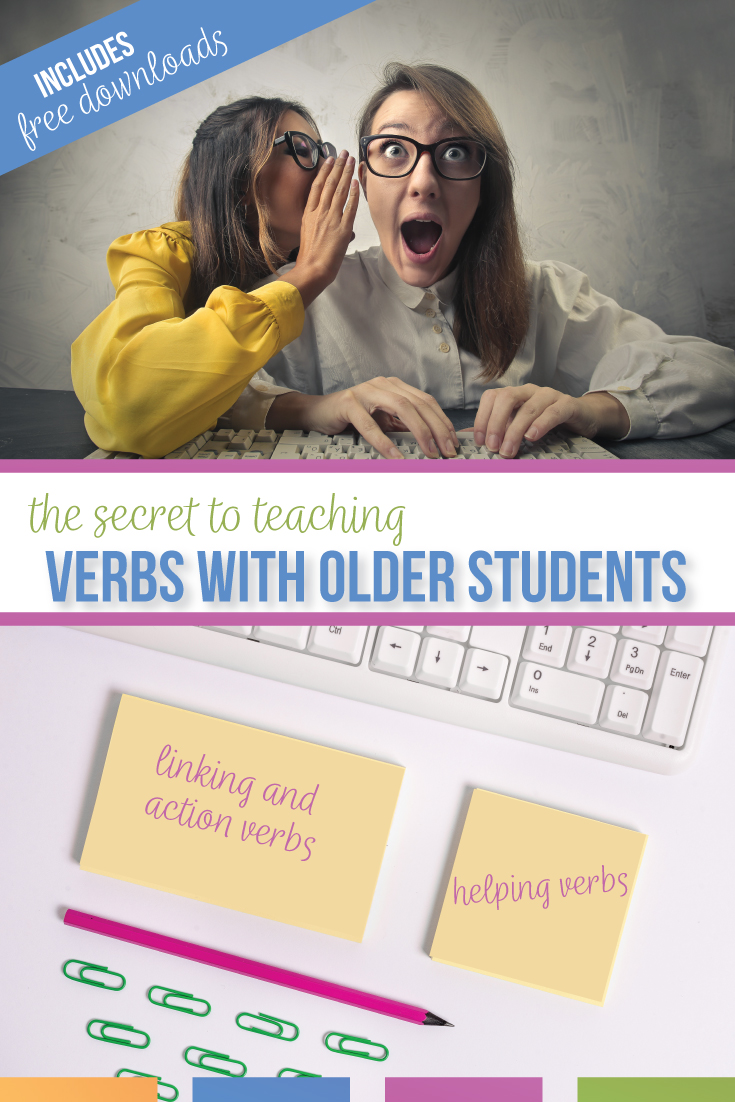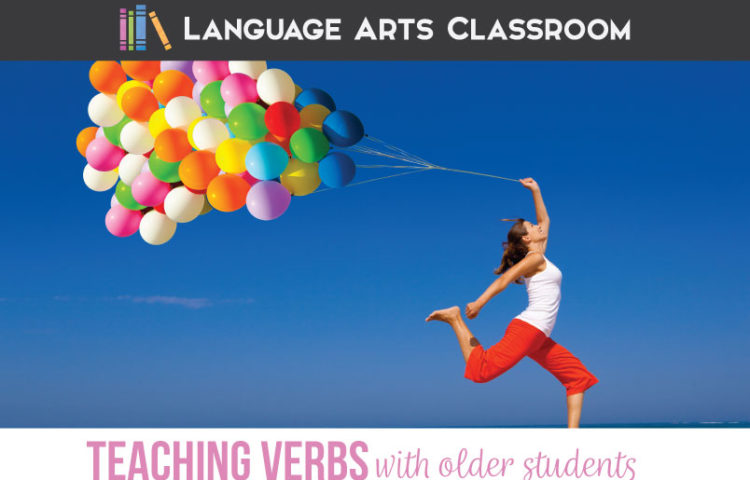Verb activities are important because so many future grammar lessons build off verbs. Verbs are powerful tools in student writing and in their literature! Below, I’ve outlined vivid verb activities.
Verbs: the backbone of sentences, the fun part of sentences, the words connected to our subjects. I love verbs, and while I know that’s a weird thing to say—I love verbs, and I love teaching verbs, and I get to be goofy with students with my verbs lesson plans. Plus, I never stop teaching verbs, especially with student writing.
Can verb activities be modified for different age groups and skill levels?
Yes, verb activities can be easily modified to suit different age groups and skill levels. For younger students, activities can focus on basic verb recognition and usage, while older students can engage in activities that involve verb tenses, conjugation, and more complex sentence structures.
My classes and I spend lots of time talking about verbs, often finding the just-so-write verb for student essays. Normally, high school students can identify verbs, but they need practice with action and linking verbs. Therefore, I spend time with linking verbs lesson plans and action verbs lesson plans. My verb activities go beyond a verb worksheet.
For instance, students might need to review shifts in verb moods. The reason for review doesn’t always matter, but everyone should experience lessons outside verb worksheets. In this post, I’m reflecting on how to teach verbs to high school classes. However, many of these ideas will be perfect for verb lesson plans, middle-school-style. Adjust as necessary.
Verbs contain numerous components, and teaching them never ends. (I also never stop hunting for ways to teach verbs!) Here are some ways I manage teaching verbs, my own engaging verb activities.
Pretest and planning for grammar.
Look at the data! Before I start any lesson, I look at the pretest and analyze what needs covered. Do classes need help with basic identification. . . differences between action and linking? Are students ready for a quick review and then a study over active and passive voice? Can students manipulative verb moods? With verb lesson plans, I don’t assume. Since we’ll work so frequently with verbs, I don’t want to skimp on explanations.
Next, I provide direct instruction over verbs: helping verbs, action verbs, linking verbs, and whatever the pretest showed me where to proceed. Often, the pretest shows that students struggle with verb mood shifts. I plan to find examples in what we read to demonstrate proper shifts.
The pretest show me where to start teaching verbs, but as we progress, I start using data that students give me with our verb activities.
Connect to literature and vocabulary.
Normally when I teach direct instruction with verbs, I’m in my short story unit. To continue to establish the power of verbs, I jigsaw whatever story we are using. I will divide the short story into columns or maybe pages. Then I ask students to find verbs in their sentences from what we are currently reading. I hand out notecards, colored pencils, markers, and we create a rainbow of verbs. It’s a bulletin board of vivid verbs that students created. That’s actually one of my first bulletin boards for the year: our vivid verbs bulletin board.
As a bonus, you can create vocabulary activities from the “vivid verbs” bulletin board. Throughout the year, I continually emphasize verbs that authors use, no matter the literature.
Another simple action and linking verb activity with literature is to categorize verbs from a story and then evaluate the author’s use. This evaluative practice works incredibly well while teaching linking verbs. Readers can form an opinion about an author’s use of linking and action verbs.
Finally, another connection to literature for verb lessons include mentor sentences. When I use one mentor sentence per day as a bell ringer, students start to recognize verbs (and other parts of speech) in a low-pressure way.
Differentiate verb activities with worksheets and more.
Verbs lesson plans are not complete without differentiation. Since teaching verbs will happen throughout the school year, consider the range of levels. Grammar really starts to be differentiated with verbs because some students are totally fine with identifying verbs, and others need a larger review.
My best solution involves station work for verbs. I can rotate and work with students in a small setting. Individuals are also more likely to ask for clarification in a small group—asking in class can seem overwhelming. If you add in a sorting or scoot activity, you’ll have yourself a verb game!
Here are more ways I break down teaching verbs into differentiated sections.
Helping verbs lesson plans
When I consider how to teach verbs to with older classes, I must consider that not all students can identify the complete verb phrase. True, most students can find the subject and verb. I scaffolded my verb stations so that students can experience verb phrases with helping verbs. Eventually, students move onto finding multiple verb phrases in the same sentence.
Action verbs lesson plans
Additionally, a grammar sort helps differentiate. You can make a grammar sort with all verbs lesson plans with some sentences to create an anchor chart. Together, make a column of action verbs and linking verbs and sort verb examples. You can have them do it on a piece of paper, or you can have them do it on a poster board to add to your classroom. Grammar sorts are really nice because you can draw conclusions from those. For instance: What do all of the linking verbs have in common? Well, you can’t act them out.
And this is one of my favorite things to do is: My students and I act out our verbs together. Action verb activities are very memorable, these really gets students moving, and these stay in long-term memory. Doing something, even goofiness, is supported by brain-based research.

Linking verbs lesson plans
I generally teach action and linking verbs simultaneously. However, linking verbs lesson plans might need to be more specific. To emphasize the difference between action and linking verbs, I use a few verb activities for high school student like task cards. As we talk through the process and answers, teaching linking verbs becomes successful.
At this point, students might be rotating through stations with worksheets, a grammar sort, or task cards. Look at the data students are giving you! Classes might understand verbs, and it’s easy to add verb moods active and passive voice right there.
Typically, if I add verb moods or voice lessons at the start of the year (because the pretest pointed out those as troublesome areas), those problems are evident in student writing.
Of course, we connect verb lessons to student writing.
Connect verbs to writing
An abundance of linking verbs and passive voice in student writing? Shifts in verb moods? Really, we ELA teachers are never done with verb activities. The good news is that you can connect verb lessons to other pieces of content.
Linking verbs: We never read a book where every sentence is an action verb or where every sentence is a linking verb. Explain about balance and work on that with classes. Are students using too many linking verbs? Typically, they are. Sometimes every sentence that a writer composes follows the same format: subject, linking verb, predicate adjective.
We practice writing without linking verbs, and then we discuss the benefits of action verbs. Finally, we discuss a balance. Some linking verbs are natural in writing! Other times, action verbs convey meaning in a better way.
Verb moods? Students sometimes struggle with the subjunctive or the conditional mood. Whatever students are currently writing in your class, ask them to experiment with these verb moods after you cover their meanings. Remember that the subjunctive mood can be great fun. You might end up with mythological stories or tales about unicorns.
Verb voice. Passive voice has a place in writing, but students should not primarily write in passive voice. Empower students with lessons on verb voice so that they can determine situations where passive voice is necessary.
I can’t really emphasize enough that I’m constantly looking at data, especially from student writing. Where I take my verb lessons primarily depends on what students need. We all struggle with the right verb to use, and together, my classes discuss the connection to writing.
Emphasize WHY: Connect Verb Activities
Whenever I teach a grammatical concept, I work to bring connections to students. My final verb activities involve connecting the concepts to other areas of class.
If you look up verbs in a dictionary, what are the notes? Does this verb take an object; does this verb not take an object? Start to show your classes that we’re learning this for a reason. Whenever I plan how to teach verbs to high school students, I include the WHY. Students are going to some day see a verb that they are not familiar with, look in the dictionary, and decide how to use it.
I emphasize and discuss with my students along the way, “Hey, this is why we’re learning grammar.” Grammar is so much more than just correcting mistakes; it is empowering secondary students to understand the literature they read, the nonfiction that they read, and to question things. (Question those verbs that people use!)
Students might not think that in their head, “Oh, I’m questioning verbs!” The process will become natural to them. And that’s hopefully what we want, that grammar will become a lens that students can use to analyze, and to think about things in language arts and beyond.
Finally, I always mention domain specific vocabulary while I’m working with grammar so that it becomes natural for students and as we continue our school year, we never stop talking about verbs.
Most activities mentioned in this blog post are in my verbs grammar bundle and are perfect verb activities when you have a range of learners. Those activities typically get me through a week of instruction and provide an easy way to implement this part of speech.
Look ahead with participles, infinitives, gerunds
For advanced grammar concepts past verbs, begin teaching verbals with older students. Take a list and together, turn the verbs into participles, infinitives, and gerunds.
Even if you are not explicitly teaching verbals, a great way to hook advanced students (concerning understanding of grammar) is to show them more of English verbs.
Overall: How to Teach Verbs
One proper way for how to teach verbs does not exist. However, for me, engagement and hands-on activities are easier with verb lessons than with other parts of speech lessons. Since verbs contain so many elements (verb voice, mood), students study verbs to some degree for years. In elementary school, learners identify verbs, but in high school, they study the connotations of verbs. Verb lessons never really end.
In high school, we study vocabulary along side verb lessons to reach those higher standards. Each student gets a verb card which then becomes part of a word wall.
Students must consider the proper use of verbs in their writing and the nuance in literature and nonfiction. Making a word wall or a bulletin board helps me.
So, again, one verb lesson plan will not suffice. Teaching verbs requires an assortment of activities and creativity. Hopefully, you can adapt these ideas to your plans.
You might be interested in more parts of speech activities such as adjectives, adverbs, and prepositions.
Do you need more ideas for linking verbs lesson plans, action verbs lesson plans, or general verb lessons plans middle school style? Check out Grammar Gurus for additional support.









